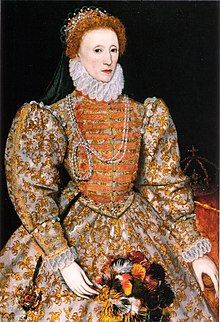Elizabeth 1
| Elizabeth I | |
|---|---|

The "Darnley Portrait" of Elizabeth I (c. 1575)
|
|
| Queen of England and Ireland (more...) | |
| Reign | 17 November 1558 – 24 March 1603 |
| Coronation | 15 January 1559 |
| Predecessors | Mary I and Philip |
| Successor | James I |
| Born | 7 September 1533 Palace of Placentia, Greenwich, England |
| Died | 24 March 1603 (aged 69) Richmond Palace, Surrey, England |
| Burial | 28 April 1603 Westminster Abbey |
| House | Tudor |
| Father | Henry VIII of England |
| Mother | Anne Boleyn |
| Religion | Anglican |
| Signature | |
Elizabeth I (7 September 1533 – 24 March 1603) was Queen of England and Ireland from 17 November 1558 until her death on 24 March 1603. Sometimes called The Virgin Queen, Gloriana or Good Queen Bess, Elizabeth was the last monarch of the House of Tudor.
Elizabeth was the daughter of Henry VIII and Anne Boleyn, his second wife, who was executed two-and-a-half years after Elizabeth's birth. Anne's marriage to Henry VIII was annulled, and Elizabeth was declared illegitimate. Her half-brother, Edward VI, ruled until his death in 1553, bequeathing the crown to Lady Jane Grey and ignoring the claims of his two half-sisters, Elizabeth and the Roman Catholic Mary, in spite of statute law to the contrary. Edward's will was set aside and Mary became queen, deposing Lady Jane Grey. During Mary's reign, Elizabeth was imprisoned for nearly a year on suspicion of supporting Protestant rebels.
In 1558, Elizabeth succeeded her half-sister to the throne and set out to rule by good counsel. She depended heavily on a group of trusted advisers, led by William Cecil, 1st Baron Burghley. One of her first actions as queen was the establishment of an English Protestant church, of which she became the Supreme Governor. This Elizabethan Religious Settlement was to evolve into the Church of England. It was expected that Elizabeth would marry and produce an heir to continue the Tudor line. She never did, despite numerous courtships. As she grew older, Elizabeth became famous for her virginity. A cult grew around her which was celebrated in the portraits, pageants, and literature of the day.
In government, Elizabeth was more moderate than her father and half-siblings had been. One of her mottoes was "video et taceo" ("I see but say nothing"). In religion, she was relatively tolerant and avoided systematic persecution. After the pope declared her illegitimate in 1570 and released her subjects from obedience to her, several conspiracies threatened her life, all of which were defeated with the help of her ministers' secret service. Elizabeth was cautious in foreign affairs, manoeuvring between the major powers of France and Spain. She only half-heartedly supported a number of ineffective, poorly resourced military campaigns in the Netherlands, France, and Ireland. By the mid-1580s, England could no longer avoid war with Spain. England's defeat of the Spanish Armada in 1588 associated Elizabeth with one of the greatest military victories in English history.
...
Wikipedia
